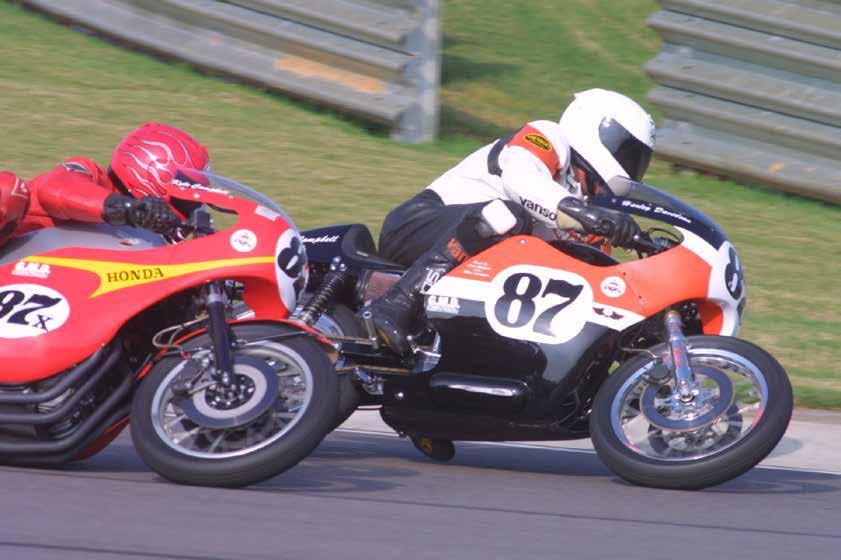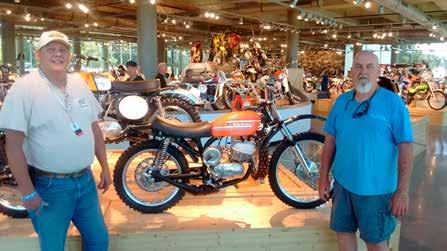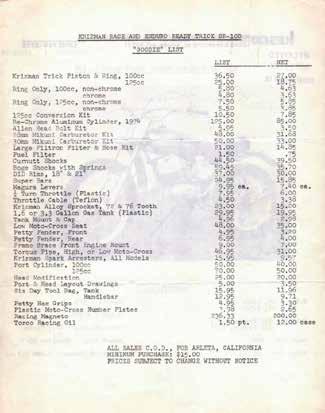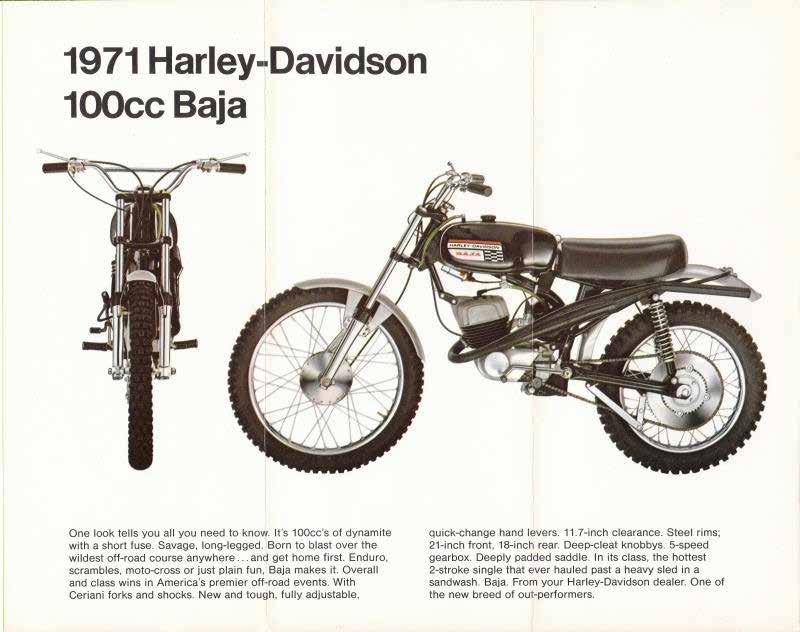
8 minute read
Blast from the Past



Shannon Silva - 350GP
TM
Barber Motorsports Park 2004
Photos by:

Sakis Vasilopoulos - 200GP


KRIZMAN KITTED HARLEY BAJA MX100
(and a Flywheel Nut)
HARLEY-DAVIDSON
BAJA
By: Rodney McAlpin (AHRMA member: 1012818) with Joe W. Koury
I have been a member of AHRMA for some time and have enjoyed the articles in your publication. The story by Keith Geisner, Finding Number 49, in a recent issue caught my attention and roused my memory. I also have a Harley-Davidson motocross bike story.
Race team truck




Babs and Rodney Fully restored and ready for display Photo: Courtesy Barber Museum
Ringing it out
At 19 years of age, I was employed as a mechanic by a Harley-Davidson dealer in Jackson, MS. My job was to work on all the smaller bikes (built by Aermacchi-Harley-Davidson) Harley was importing from Italy at that time. In the early ‘70s, Harley had an off-road/MX/enduro bike known as the BAJA 100. We were having our struggles selling the small bikes due to the influx of the Japanese brands. Harley-Davidson had teamed with Jack Krizman in California to build a racing package for the Baja. It was only available to dealers. Richard Campbell, owner of the shop, told us about the kit and asked if we would be willing to build and race a Baja 100. Needless to say, we were all in. The dealership contacted Jack and purchased the kit, which we installed and raced, sponsored by Harley Davidson. (The cylinder was sent to California where Jack bored it to 125cc and replated it.) This obviously predated the official factory Harley MX 250 team. It was somewhat of an experiment and test to see if Harley-Davidson would be accepted into the MX world. All of this came about due to the efforts of our Harley dealer rep, Sonny Womack. Richard, the boss, assumed the ‘Big Shot’ role, walking around, drinking beer and watching us work.
The first time we showed up at a race, we were ridiculed by a few of the other racers of all the various Yamahas and European bikes. They had to eat their words after we pulled the holeshot in our first race and didn’t waste much time afterward, checking out the little Harley. The bike did very well and improved as we worked with Jack on issues to make it even better. We had a shifting problem that caused the transmission to skip second gear. After a few calls to Jack, and a shift fork modification, we had the gear sequence setback sorted. Sadly, the dealership was sold, and the bike retired. It was put into storage and neglected for over 40 years, but not before one final gremlin was discovered. A loss of spark launched a futile search for a replacement condenser. Harley had sold all their parts to Cagiva by then, so we sourced a part from another supplier. But in the process of replacing the condenser, the flywheel nut disappeared, and that was the last time I saw the bike.
Catchin' some air



Mid-'70s racing


Pre-restoration (right side) A diamond in the rough found at Diamond Don's swap meet of all places Pre-restoration (left side)

In 2018, I decided to search for some of the old bikes I once raced in an attempt to buy them back. The BAJA 100 was located in a barn in Greenwood, MS, behind an ATV shop owned by Vernon Rich Jr. Vernon promised me some photos and a price but before I could hook up with him, he’d swapped the bike and two others to a guy named James Neal. At that time, I was prepping to head to Diamond Don’s (I ride trials on a 1976 Montesa Cota 348). I was already making plans to get it running and let the grandkids ride it so I figured I’d resume the search when I returned. While walking down one of the gravel roads at Diamond Don’s swap meet, I spotted an orange motorcycle sharing space with several others on a trailer. I asked the seller, “What do you know about this motorcycle?” The seller was James Neal, from Wynona, AR. He said all he knew was a guy from Illinois was supposed to pick it up, and the price was $900. He wouldn’t budge on the nine hundred bucks, so I bought the bike, but only after I confirmed it was indeed the bike we’d built and raced in the ‘70s. The flywheel nut was still missing. It hadn’t been ridden again after my last race in late 1975.
I had someone haul it back to Arkansas since my trailer was full. The bike was in rough condition, but restorable. Brian Slark, of Barber Motorsports Museum, asked me what I was going to do with the bike. I told him it was a ‘grandkids project.’ He said the bike might be the only survivor with a Krizman kit and asked me to think about donating it to the museum. I researched the only other Krizman kit I could find, supposedly at Perkins Harley-Davidson in California. That search came up empty; the restoration ensued.
In 2019, the bike was donated to the Barber Museum where it is now on display. When we arrived at the museum, we unloaded the Baja, started it up and rode it around the parking lot. I remember two things: it was loud, and after George Barber checked it out, he said, “It’s going on display today.” We took a few photos, it was taken down to the shop for prep, and the rest is a continuation of history as countless museum goers now get to enjoy the little Baja MX 100.
Rodney lives in Byram, MS, with his wife, Babs, and is an active AHRMA competitor. He owns several vintage motorcycles and repairs, restores and rides them all. Here are a few of the bikes he has: 1970 Honda Z50, 1978 H-D SX250, 1979 Honda CB750F, 1976 Kawasaki KT250, 1971 Suzuki JR50, 1973 Yamaha GT80. He is currently helping a friend restore a 1928 Excelsior Henderson Four that wound up east of the Mississippi. The owner traded it for a bus ticket back west after it broke down during a cross-country trip.
Rodney lives in Byram, MS, with his wife, Babs, and is an active AHRMA competitor. He owns several vintage motorcycles and repairs, restores and rides them all. Here are a few of the bikes he has: 1970 Honda Z50, 1978 H-D SX250, 1979 Honda CB750F, 1976 Kawasaki KT250, 1971 Suzuki JR50, 1973 Yamaha GT80. He is currently helping a friend restore a 1928 Excelsior Henderson Four that wound up east of the Mississippi. The owner traded it for a bus ticket back west after it broke down during a cross-country trip.

On Display at Barber Motorsports Museum Rodney (L) and fellow race team member Buddy Blackwell pose with the bike

ABOUT Rodney McAlpin
Jack Krizman, engineer, was an early 70’s Aermacchi-HarleyDavidson two stroke engine development pioneer. He designed many performance aftermarket racing parts for the two stroke Harley-Davidsons which included brakes, shocks, ignition, clutch, crankshaft, cylinders, cylinder heads, reed valves and frames. Krizman invented and patented the spark arrester for motorcycles, developed his own signature pipe designs and later the Filtron air filter. The businesses started from his garage in the family home in California’s San Fernando Valley. Motorcycles were Jack's passion. Jack’s wife, Gloria, bought him his first motorcycle in the 1950s, and he was hooked. Jack raced and rode motorcycles all over the world and worked closely with Honda, Suzuki, Husqvarna and raced for HarleyDavidson as well as sponsored teams for Harley-Davidson. The 1968 Model ML Rapido was extensively modified by Jack Krizman of KESCO to create the ML Rapido Baja Prototype. He created it for the subsequent production of the 1970 MSR100 Baja. It featured a Filtron air filter, high exhaust pipe and a trail sprocket. The instruments were removed, the front forks, seat and rear shocks replaced. He distributed his ‘Goodie’ parts through his company, Krizman Engineering & Sales Co. He passed in 2006.
Aermacchi began building motorcycles in 1951. In 1956, the first four-stroke overhead valve engine was produced. You will find descendants of these models at every AHRMA roadrace and a few off-road events. These ‘Sprints,’ with their potent horizontal engine design, were built in the 1960s and ‘70s and are popular in 200GP, 250GP and 350GP roadrace classes. In 1960, Harley-Davidson purchased 50% of Aermacchi's motorcycle division. The Italian branch of the brand was named 'Aermacchi-Harley-Davidson.’ The remaining motorcycle holdings were sold to AMF-Harley-Davidson in 1974, with production continuing at Vares, Italy, including several different single-cylinder two-stroke models. Cagiva bought the business in 1978.
Sources: thesungazette.com; msolisvintagemotorcycle. com; wikipedia.com

Krizman goodie list
Unloading the bike at Barber Motorsports Museum


Baja Brochure







